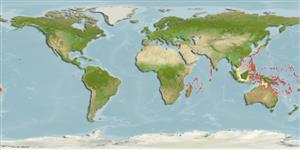Lớp phụ (Subclass) cá vây tia >
Perciformes (Perch-likes) >
Trichonotidae (Sanddivers)
Etymology: Trichonotus: Greek, thrix = hair + Greek, noton = back (Ref. 45335).
Môi trường / Khí hậu / Phạm vi
Sinh thái học
; Biển Cùng sống ở rạn san hô; Mức độ sâu 10 - 40 m (Ref. 90102). Subtropical, preferred ?
Western Indian Ocean: Maldives (Ref. 30829). Western Pacific: Indonesia to Fiji, north to the Ryukyu Islands, south to the Coral Sea.
Bộ gần gũi / Khối lượng (Trọng lượng) / Age
Maturity: Lm ? range ? - ? cm
Max length : 18.0 cm SL con đực/không giới tính; (Ref. 559)
Các tia vây lưng cứng (tổng cộng): 3; Các vây lưng mềm (tổng cộng): 43-45; Tia cứng vây hậu môn 1; Tia mềm vây hậu môn: 39 - 42. Identified by the long filaments on the dorsal fin of the male (Ref. 48636). Body scaleless above and below lateral line on anterior half (Ref 12934).
Found in coastal reef slopes and deep outer reef lagoons in current channels. Usually in large groups with several large males (Ref. 48636). Inhabits sand-rubble bottoms (Ref. 90102). Found hovering above sandy slopes. Usually forms a harem of one male-phase fish and about a dozen female-phase fish (Ref. 37240). Normally buried when no current is running (Ref. 48636).
Life cycle and mating behavior
Chín muồi sinh dục | Sự tái sinh sản | Đẻ trứng | Các trứng | Sự sinh sản | Ấu trùng
Shimada, K. and T. Yoshino, 1984. A new trichonotid fish from the Yaeyama Islands, Okinawa Prefecture, Japan. Jap. J. Ichthyol. 31(1):15-22. (Ref. 37240)
IUCN Red List Status (Ref. 115185)
CITES (Ref. 94142)
Not Evaluated
Threat to humans
Harmless
Human uses
Thêm thông tin
Các tài liệu tham khảoNuôi trồng thủy sảnTổng quan nuôi trồng thủy sảnCác giốngDi truyềnTần số alenDi sảnCác bệnhChế biếnMass conversion
Các công cụ
Special reports
Download XML
Các nguồn internet
